Surfers chasing the perfect wave, divers exploring the depths, and swimmers embracing the open water all rely on the same trusted companion: a wetsuit.
But after countless sessions in the water, it’s no secret that wetsuits can accumulate more than just memories—they can gather salt, sweat, sand, and odours, too.
To ensure that your wetsuit continues providing comfort and protection, it’s essential to know how to wash a wetsuit.
Here we explain the secrets of wetsuit care, from the do’s and don’ts of washing to the best practices for preserving its longevity. Keep reading for all you need to know!
How Do You Clean a Wetsuit?
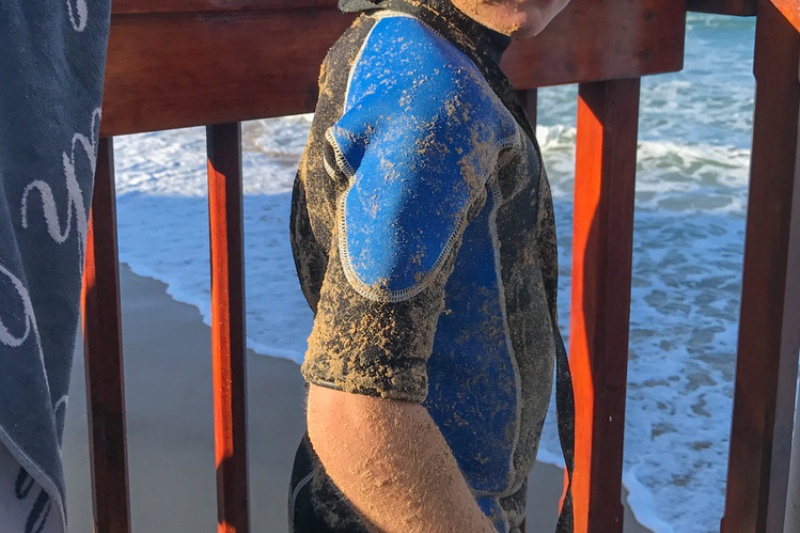
The quickest and easiest way to wash a wetsuit is by rinsing, handwashing, and hanging it up to dry. However, things are a little more technical than they seem.
Wetsuits are made from a synthetic rubber material called neoprene, which is sensitive to heat and chemicals.
Therefore, using the correct method is essential for effective cleaning without causing damage. Follow the steps below to learn how to wash a wetsuit the right way.
Step 1: Rinse your wetsuit immediately
Rinse your wetsuit thoroughly with fresh water as soon as possible after each use, ideally as soon as you take it off.
This helps remove salt, sand, sweat, and other debris that can contribute to odours.
Here are some tips to ensure you rinse your wetsuit properly:
- Use fresh water: Rinse your wetsuit with fresh, lukewarm water. Avoid using hot water, as hot temperatures can damage the delicate neoprene. Cold water is also fine, but lukewarm water is more effective at removing salt and grime.
- Rinse thoroughly: To ensure a thorough rinse, fully submerge the wetsuit in a large bucket or bathtub of water. Turn your wetsuit inside out and rinse both sides, ensuring you focus on areas where sweat and sand tend to accumulate, such as the armpits and crotch.
- Gentle agitation: While rinsing your wetsuit, gently agitate it by moving it around in the water using your hands. This allows the water to penetrate all the nooks and crannies and helps dislodge any trapped particles or salt.
Ideally, you should handwash your wetsuit now using a wetsuit-specific cleaner. While rinsing is a quick way to prevent salt-related damage, it won’t address deep cleaning or unpleasant smells.
However, if you’re short on time, skip the next step and ensure you dry and store your wetsuit correctly before washing it later or using it for your next surf.
Step 2: Handwash your wetsuit
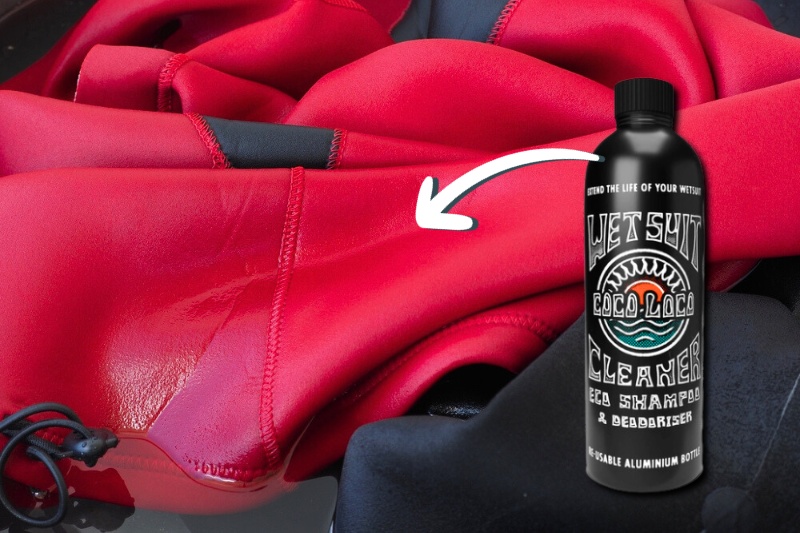
With the initial rinse complete, it’s time to handwash your wetsuit:
- Soak the wetsuit: Refill the bucket or bathtub with clean water and add a small amount of wetsuit-specific cleaner like Coco Loco Wetsuit Cleaner Shampoo. Do not use regular laundry detergents, as they damage the neoprene. Submerge the wetsuit in the water and allow it to soak for 15 to 20 minutes.
- Gently scrub the wetsuit: After soaking, gently scrub the wetsuit with your hands or a soft brush, paying particular attention to areas that tend to collect sweat and bacteria (armpits, crotch, etc.). Avoid using excessive force, as the flexible properties of neoprene mean it can tear easily, and your wetsuit will need repairing.
- Rinse with clean water: Drain the soapy water and refill the container/bathtub with clean, lukewarm water, then rinse the wetsuit thoroughly until all soap residue is removed. You may need to rinse it several times to be sure all soap residue is completely removed from the material.
Tip: If you need more advice on how to handwash clothes, check our guide to handwashing clothes.
Step 3: Dry & store your wetsuit correctly

After rinsing/washing is complete, hang the wetsuit to dry in a shaded, well-ventilated area. Avoid direct sunlight and excessive heat, as this can cause UV and ozone damage to the neoprene.
We recommend using a wide, padded hanger or a wetsuit-specific hanger to help the fabric maintain its shape.
Alternatively, fold the wetsuit in half at the waist over a horizontal hanger and leave to drip dry.
Ensure your wetsuit is completely dry before storing it—storing it while damp can contribute to foul odours and increase the risk of mould and bacterial growth.
Store your wetsuit flat or hung up rather than folded to prevent creases and maintain its shape.
Can You Put Your Wetsuit in the Washing Machine?
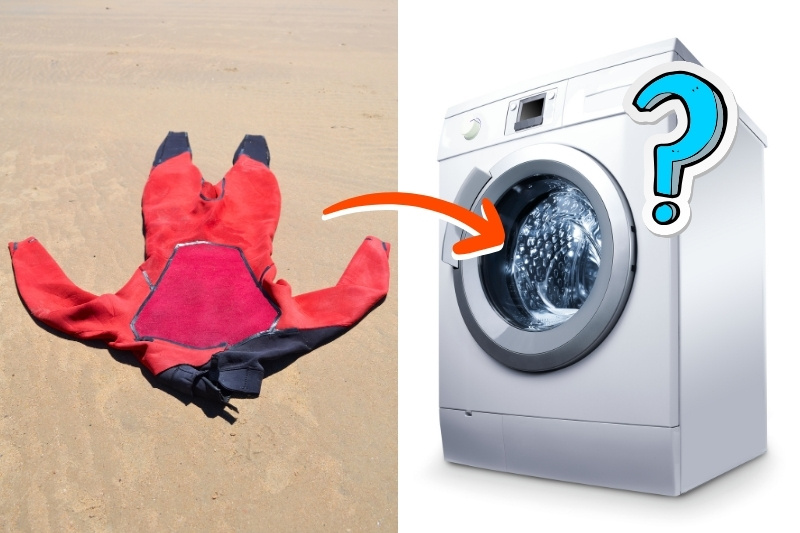
It’s generally not recommended to put your wetsuit in a washing machine. Neoprene, the material most wetsuits are made of, is delicate and can be easily damaged by the agitation and spinning of a washing machine.
Here are a few reasons why you should avoid machine washing your wetsuit:
- Tearing and abrasion: The agitator in a washing machine and the friction caused by other clothes can lead to tears, abrasions, and damage to the neoprene material.
- Loss of shape: Wetsuits can lose their shape when subjected to the twisting and stretching that occurs during machine washing.
- Zip and Velcro damage: The zip and Velcro closures on wetsuits can get caught in the washing machine, potentially causing damage.
- Detergent issues: Regular laundry detergents can be harsh and unsuitable for cleaning neoprene. They can strip the neoprene of its natural oils and cause it to become brittle.
Instead of machine washing, it’s best to follow the hand-cleaning method described in the previous subheading.
Hand washing allows you to control the cleaning process more carefully and minimise the risk of damaging your wetsuit.
Use a wetsuit-specific detergent, and be gentle when scrubbing and rinsing the wetsuit for best results.
How Do You Wash a Wetsuit Without a Wetsuit Cleaner Product?
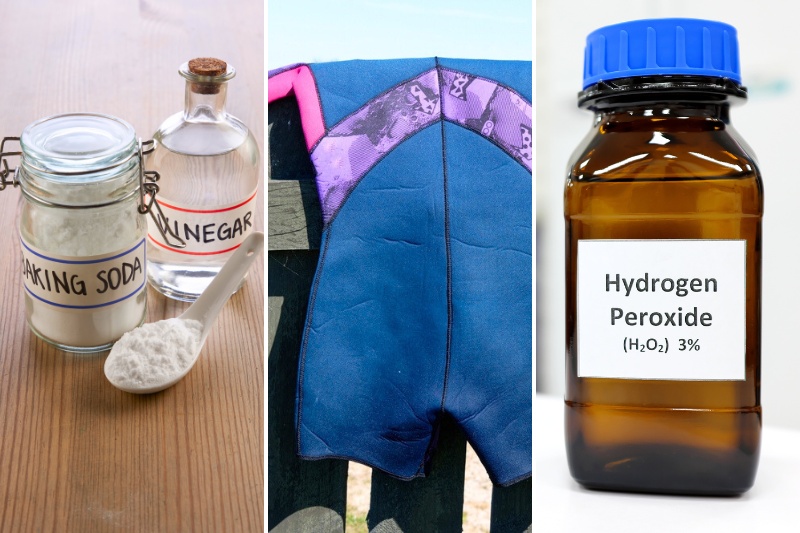
If you don’t have a wetsuit-specific cleaner, you can use mild, non-detergent soap or baby shampoo in its place.
You don’t need much—a teaspoon or so should suffice. Just ensure the soap you use doesn’t contain harsh chemicals or additives that could harm the neoprene.
For more stubborn stains or smelly wetsuits, you can enlist the help of one of three common household ingredients instead: white vinegar, bicarbonate of soda, or hydrogen peroxide:
- White vinegar solution: White vinegar can help neutralise odours and disinfect your wetsuit. Mix one part white vinegar with three parts water and soak your wetsuit in this solution for up to 20 minutes. Rinse thoroughly with fresh water afterwards to remove the vinegar smell.
- Bicarbonate of soda: Bicarbonate of soda is known for its odour-neutralising properties. Create a paste by mixing bicarbonate of soda with water and apply it to areas with stubborn stains or smelly spots. Gently scrub with a soft brush, then rinse thoroughly.
- Hydrogen peroxide: Hydrogen peroxide can tackle tough stains and disinfect your wetsuit. Dilute hydrogen peroxide with water (typically one part hydrogen peroxide to three parts water), spot-clean the stained areas, and rinse thoroughly.
When using these alternatives, always spot-test a small, inconspicuous area of your wetsuit first to ensure they don’t cause any adverse reactions or discolouration. Additionally, rinse your wetsuit thoroughly with fresh water after cleaning to remove any cleaning solution residue.
Should You Rinse Your Wetsuit After Every Use?
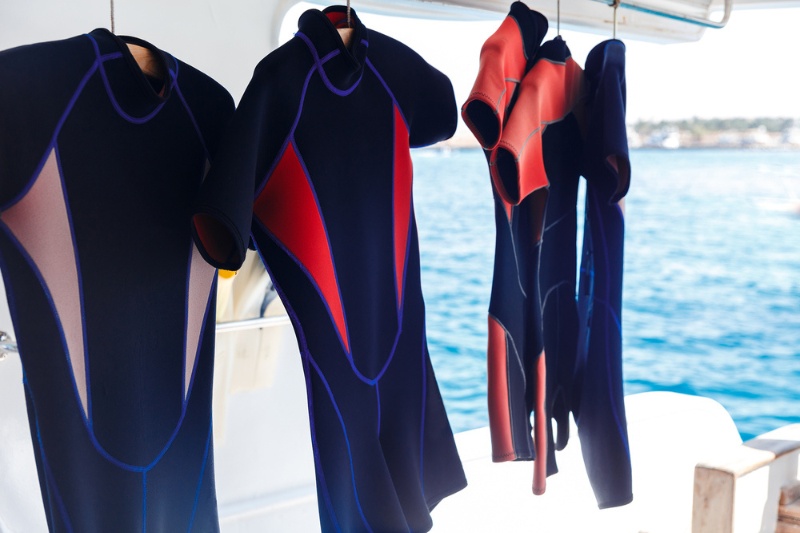
You should get into the habit of rinsing your wetsuit after every use. Even if you don’t have time to complete the entire washing process immediately, rinsing your wetsuit straight after you finish using it has several significant benefits:
- Salt removal: If you’ve been in saltwater (e.g., the ocean), rinsing your wetsuit helps remove salt residues. Salt can be abrasive and contribute to premature wear and tear of the neoprene material, so removing it instantly helps prolong the life of your wetsuit.
- Sand and debris removal: Rinsing your wetsuit also helps get rid of sand, dirt, and other debris that may have accumulated during your water activities. Like salt, these particles can scratch and damage the neoprene over time.
- Bacteria and odour prevention: Rinsing helps remove sweat, body oils, and other organic materials from the wetsuit. These substances can foster the growth of bacteria, leading to unpleasant smells. Removing them promptly helps prevent this issue.
In short, rinsing your wetsuit after every use helps prolong its lifespan, maintain its functionality, and keep it smelling fresh.
This regular maintenance also ensures that your wetsuit remains comfortable and hygienic for your next water adventure.
Dos and Don’ts of Wetsuit Washing

Washing a wetsuit may seem straightforward, but there are common mistakes that people make that can lead to damage or reduce the lifespan of their wetsuits.
Here are some common mistakes to avoid when washing wetsuits and what you should be doing instead.
Dos
- DO use mild, non-detergent soap, wetsuit-specific cleaners, or alternative gentle cleaning solutions.
- DO stick with lukewarm or cold water while washing and rinsing your wetsuit to help it maintain its flexibility.
- DO use gentle, circular motions when cleaning, and be cautious around seams and zippers. Neoprene is a delicate material.
- DO turn your wetsuit inside out and clean both the inside and outside surfaces, focusing on areas like the armpits and crotch.
- DO hang your wetsuit in a shaded, well-ventilated area away from direct sunlight and let it drip dry.
- DO ensure your wetsuit is completely dry before returning it to storage.
- DO store your wetsuit in your closet. Hang it either on a wide-shouldered hanger or folded at the waist on a horizontal hanger.
Don’ts
- DON’T use regular laundry detergents or harsh cleaning products. These can contain chemicals that can damage the neoprene material.
- DON’T use hot water when washing your wetsuit. Neoprene can be sensitive to high temperatures, causing it to become brittle.
- DON’T scrub too vigorously or use abrasive brushes that can damage the neoprene.
- DON’T forget to clean the inside of your wetsuit, where sweat, oils, salt, sand, and odours can accumulate.
- DON’T dry your wetsuit in direct sunlight or near heat sources like radiators or heaters. Never put your wetsuit in the tumble dryer.
- DON’T store your wetsuit when it’s still wet or damp, which can lead to the growth of mould and mildew.
- DON’T store your wetsuit in a sealed, airtight bag or container that can trap moisture and odours inside the material.

Hannah has a passion for cleaning. She worked her way around Australia by cleaning hostels in exchange for free accommodation and used her cleaning skills to bag a job as a chalet host for a luxury ski company in France.






